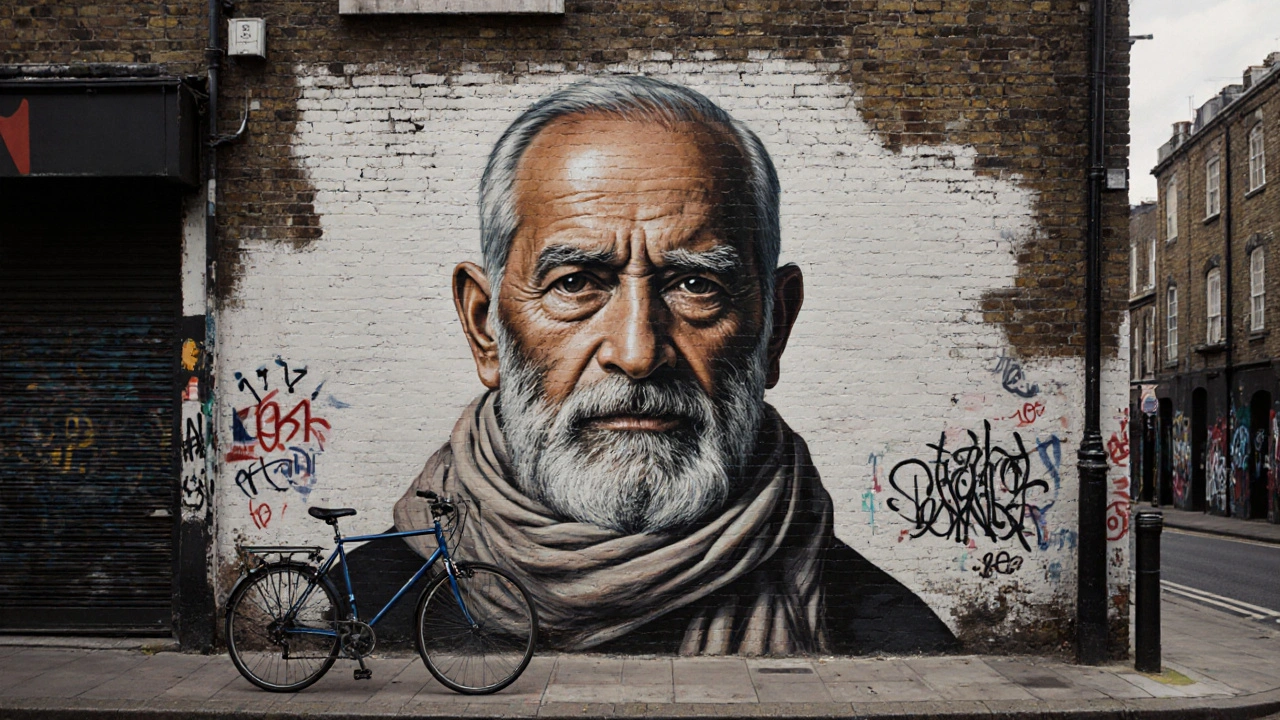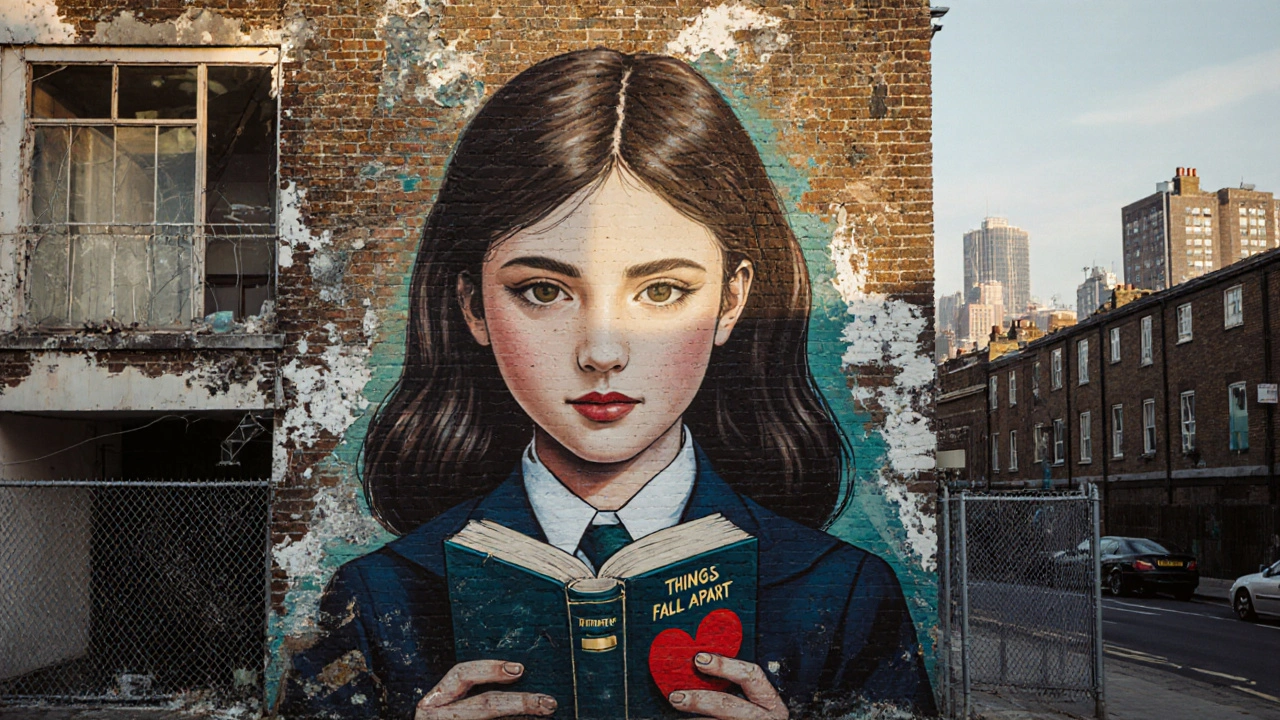
Walk through any alley in East London and you’ll see faces staring back at you-not from photos or posters, but painted in bold, haunting detail across entire brick walls. These aren’t random tags or throw-ups. They’re the work of Smug One, a street artist whose portrait murals have turned quiet corners of the city into open-air galleries. If you’re looking for street art that stops you in your tracks, Smug One’s pieces in London are among the most powerful you’ll find.
Who Is Smug One?
Smug One isn’t a household name like Banksy, but in London’s underground art scene, he’s legendary. His real name isn’t public, and he rarely gives interviews. What’s known is that he started painting in the early 2010s, mostly around Hackney and Shoreditch. He didn’t want to be famous-he wanted to be seen. His work focuses on everyday people: a bus driver with tired eyes, a teenager with headphones, an elderly woman holding a shopping bag. No celebrities. No heroes. Just real faces,放大到墙面上,带着沉默的力量。
Unlike many street artists who use spray cans for abstract shapes or political slogans, Smug One paints with a mix of spray paint, brushes, and stencils. He builds portraits layer by layer, starting with a loose sketch, then refining the eyes, the wrinkles, the texture of skin. He doesn’t use photo projections. He works from memory, from photos he takes himself, from people he meets on the street. That’s why his murals feel alive.
Where to Find Smug One’s Murals in London
There’s no official map. Smug One doesn’t announce his pieces. You find them by wandering. But after years of tracking his work, here are the most consistent and impactful locations to look.
- Brick Lane, E2 - Near the corner of Fournier Street, a large portrait of an older South Asian man with a scarf and a calm gaze. The mural is over 6 meters tall. The way the light hits his eyes changes throughout the day-sometimes it looks like he’s about to speak.
- Shoreditch High Street, E1 - On the side of a shuttered betting shop, a young Black woman with braids and a red coat. She’s looking slightly off-frame, as if she’s just turned away from the viewer. The paint has faded a bit since 2022, but the emotion hasn’t.
- Camden Market, NW1 - Behind the canal, on a wall next to a tattoo parlor, a portrait of a middle-aged man with a beard and a faded band t-shirt. He’s holding a cup of tea. The steam from the cup is painted in white spray, almost invisible unless you stand close.
- Peckham Rye, SE15 - A full-body portrait of a teenage girl in a school uniform, holding a book. The mural spans two stories. The book’s title is barely legible, but it’s Things Fall Apart by Chinua Achebe. The artist added a small red heart on the spine.
- Wapping, E1 - One of his earliest surviving pieces, painted in 2014. A dockworker from the 1950s, his face weathered, his hands rough. The mural has been touched up twice by local volunteers. It’s the only one with a small plaque that reads: “For those who built this city and were forgotten.”
Some murals have vanished. A piece near Old Street disappeared in 2023 after the building was renovated. Another, on a wall in Bermondsey, was painted over by a developer in 2024. That’s the reality of street art. It’s temporary. That’s why people still come to see them.
Why These Murals Matter
London is full of art. The Tate Modern, the National Portrait Gallery, the Victoria and Albert-they all house works by famous names. But Smug One’s murals are different. They don’t ask you to admire them from a distance. They ask you to recognize them.
Each face represents someone who lives here, works here, rides the Tube here. A 2023 survey by the London Street Art Collective found that 78% of locals who passed Smug One’s murals said they felt a sense of connection-not to the artist, but to the person in the painting. One woman told a reporter she saw her own mother in the portrait on Brick Lane. Another said the man in Camden looked like his late father.
That’s the power of scale. When a face is painted 10 feet tall, it can’t be ignored. It demands presence. It turns a blank wall into a memorial, a conversation starter, a quiet act of resistance against the idea that ordinary people don’t deserve to be remembered.

How to Find More Murals (Without a Tour)
You won’t find Smug One’s work on Instagram tours or Google Maps pins. He doesn’t tag his pieces. But here’s how to find them yourself:
- Start in East London-Hackney, Tower Hamlets, Newham. That’s where most of his work lives.
- Look for walls that look recently painted, even if they’re not shiny new. Smug One often uses muted tones-ochre, slate gray, faded blue.
- Pay attention to eyes. His portraits always have a slight asymmetry in the pupils. One eye is ever so slightly darker. It’s a signature.
- Ask local shop owners. Many know when a mural appears. They’ll point you to the alley behind their store.
- Visit on overcast days. The soft light reveals texture in the paint you won’t see in bright sun.
Don’t bring a camera on your first visit. Just look. Stand there for a minute. Let the face look back at you.
What Makes Smug One’s Work Unique?
There are other artists who paint portraits on walls. But Smug One’s work stands out because of three things:
- No heroism - He doesn’t paint activists, athletes, or icons. He paints people who go unnoticed.
- No color overload - He uses maybe five colors per piece. Most are earth tones. The emotion comes from light and shadow, not neon.
- No signature - He never signs his work. No initials. No dates. No tags. You only know it’s his when you’ve seen enough of them.
His style is influenced by documentary photography-think Gordon Parks or Dorothea Lange-but translated into urban space. He doesn’t want you to think, “That’s beautiful.” He wants you to think, “I know that person.”

What’s Next for Smug One?
He’s still active. In early 2025, a new mural appeared near the Royal Docks. It’s a portrait of a young woman in a hijab, holding a seedling. The background is a map of London, with neighborhoods marked in tiny dots. No one knows if it’s his, but the style matches. The city is changing. New buildings rise. Old ones get demolished. But these portraits? They stay. Until they don’t.
That’s why people still walk miles to see them. Not because they’re famous. Not because they’re trendy. But because they’re real.
Is Smug One the same artist as Banksy?
No. Smug One and Banksy are completely different artists. Banksy uses satire, political symbols, and hidden messages. Smug One focuses on quiet, everyday people with no hidden meaning. Banksy signs his work; Smug One never does. Their styles, subjects, and intentions are not related.
Are Smug One’s murals legal?
Most are painted without permission, which technically makes them illegal. But in London, many are tolerated-or even quietly protected-because of their cultural value. Local councils sometimes repaint them after weather damage. Some building owners have even asked him to paint their walls. It’s a gray area, but the public response has made them de facto landmarks.
Can I take photos of Smug One’s murals?
Yes. Taking photos for personal use is fine. Don’t use them for commercial purposes without permission-though no one has ever sued over it. Be respectful. Don’t climb walls, block entrances, or leave graffiti near the mural. These are public spaces, not photo studios.
How long do Smug One’s murals last?
Most last between 3 to 8 years, depending on weather, building maintenance, and urban development. Murals in shaded alleys last longer. Those facing direct sun or near busy roads fade faster. Some have been preserved by community groups. Others disappear overnight when a building is demolished.
Where can I learn more about Smug One?
There’s no official website or book. The best way to learn is to see his work in person. Some local art collectives, like the East London Street Art Archive, have photo records from 2015-2024. You can also find interviews with people who’ve seen him paint-though he never speaks to the press. His art speaks for itself.
Final Thoughts
Smug One’s murals aren’t about fame. They’re about memory. They’re about saying, “You were here. You mattered.” In a city that moves fast-where people change neighborhoods, jobs, even identities-these portraits hold still. They remind us that behind every face on the Tube, every person rushing past a café, there’s a story. And sometimes, if you’re lucky, you’ll see it on a wall.